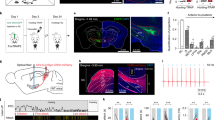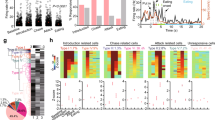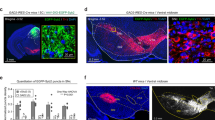Abstract
The neurons of the cerebral ganglia controlling the movements of the hunting apparatus of the predatory pelagic pteropod mollusc, Clione limacina, are described in detail. A large group of high-threshold, electrically interconnected neurons, A, was identified, the impulse activity of which leads to the opening of the skin folds and the forward ejection of the hunting tentacles of the clione. Group B neurons which exhibit a constant background activity and which receive powerful inhibitory inputs from the A cells, conversely, induce the contraction and the withdrawal of the hunting tentacles into the head. The third group, are the C neurons, the impulse activity of which leads to the drawing together of the skin folds covering the hunting apparatus. The effect of such mediators as serotonin, dopamine, and gamma aminobutyric acid acid on the identified neurons was investigated. Serotonin depolarizes both A and B neurons, but the activation of the hunting apparatus appears to be an integrated effect: the activated A neurons inhibit the B neurons due to powerful IPSP, interrupting the direct excitatory effect of serotonin. Dopamine in various concentrations exerts the opposite effect: at low concentrations only B cells are activated and the tentacles are withdrawn into the head; at high concentrations the A neurons begin to operate; these neurons inhibit the B cells and activate the hunting apparatus. GABA exerts an integral, well-coordinated effect on the neurons controlling the movements of the hunting apparatus, and effect which is directed toward the activation of hunting behavior: it depolarizes-activates A neurons and hyperpolarizes-inhibits B and C neurons.
Similar content being viewed by others
References
Yu. I. Varshavskii, I. M. Gel'fand, T. G. Delyagina, E. S. Meyzerov, et al., “Certain mechanisms of the control of locomotion in the pteropod mollusc Clione limacina,”Zh. Obshch. Biologii,48, No. 3, 325–339 (1987).
Yu. M. Burmistrov, “The circulation of the nerve impulse in the system of lateral giant axons of the crayfish,”Biofizika,10, 90–97 (1965).
N. P. Wagner,Invertebrates of the White Sea, Vol. 1 [in Russian], Saint-Petersburg, (1885).
E. A. Kabotyanskii and D. A. Sakharov, “Neuronal correlates of serotonin-dependent behavior of the pteropod mollusc clione,”Zh. Vyssh. Nerv. Deyat.,40, No. 4, 739–753 (1990).
N. M. Litvinova and G. N. Orlovskii, “Alimentary behavior of the pteropod molluscClione limacina,”Byul. MOIP. Old. Biol.,90, No. 4, 73–77 (1985).
T. P. Norekyan, I. S. Zakharov, and P. M. Balaban, “Neurophysiological mechanisms of change in the reaction to defensive stimuli during the activation of alimentary behavior in the pteropod molluscClione limacina,”Dokl. AN SSSR,302, No. 2, 491–494 (1988).
D. A. Sakharov and E. A. Kabotyanskii, “The integration of behavior of a pteropod mollusc by dopamine and serotonin,”Zh. Obshch. Biol.,47, No. 2, 234–245 (1986).
A. A. Ukhtomskii,The Doctrine of the Dominant, in:Collected Works, Vol. 1 [in Russian], Leningrad (1950).
Zh. P. Shuranova and Yu. M. Burmistrov,The Neurophysiology of the Crayfish [in Russian], Nauka, Moscow (1988).
G. Chapman, “The hydrostatic skeleton in the invertebrates,”Biol. Rev. of the Cambridge Philos. Society,33 (3), 338–371 (1985).
B. Dale, “Blood pressure and its hydraulic function inHelix pomatia L.,”J. Exptl. Biol.,59, No. 2, 477–490 (1973).
B. Dale, “Extrusion, retraction and respiratory movements inHelix pomatia in relation to distribution and circulation of the blood,”J. Zool.,173, No. 3, 427–439 (1974).
B. Granzow and S. B. Kater, “Identified higher-order neurons controlling the feeding motor program ofHelisoma,”Neuroscience,2, 1049–1063 (1977).
E. A. Kabotyanski and D. A. Sakharov, “Monoamine-dependent behavioral states in the pteropod mollusc Clione limacina,” in:Neurobiology of Invertebrates: Transmitters, Modulators, and Receptors, Vol. 36, J. Salanki and S. Roza (eds.), Symposia Biologica Hungarica, Budapest (1988), pp. 463–477.
I. Kupfermann and K. R. Weiss, “The role of serotonin in arousal of feeding behavior ofAplysia,” in:Serotonin Neurotransmission and Behavior, Cambridge (1981), pp. 255–287.
C. M. Lalli, “Structure and function of the buccal apparatus ofClione limacina (Phipps) with a review of feeding in gymnosomatous pteropods,”J. Exptl. Marine Biol. Ecology,4, 101–118 (1970).
C. M. Lalli and R. W. Gilmer,Pelagic Snails. The Biology of Holoplanktonic Gastropod Mollusks, Stanford University Press (1989).
Ch. M. Lent, “Serotonin: a chemical mediator of feeding behavior in leeches,” in:Signal Molecules and Mechanisms of Animal Behavior. Abstracts. Symposium, Pushchino (1989), p. 36.
T. P. Norekyan and I. S. Zakharov, “Effects of serotonin on pleural and pedal neurons, involved in inhibitory control of locomotion in Clione,” in:Signal Molecules and Mechanisms of Animal Behavior. Abstracts. Symposium, Pushchino (1989), p. 44.
G. Rao, C. A. Barnes and B. L. McNaughton, “Intracellular fluorescent staining with carboxylflourescein: a rapid and reliable method for quantifying dye-coupling in mammalian central nervous system,”J. Neurosci. Methods,16, No. 2, 251–263 (19860.
J. E. Richmond, A. D. Murphy, A. G. M. Bulloch, and K. Lukowiak, “Evidence of an excitatory effect of GABA on feeding patterned motor activity ofHelisoma trivolvis,”Soc. Neurosci. Abstr.,12, Part 2, 792 (1986).
D. Sakharov, “Integrative function of serotonin common to distantly related invertebrate animals,” in:The Early Brain, H. Gustafsson and M. Reuter (eds.), Academi Press, Abo (1990), pp. 73–88.
R. A. Satterlie and A. N. Spencer, “Swimming in the pteropod mollusc,Clione limacina. II. Physiology,”J. Exptl. Biol.,116, No. 1, 205–222 (1985).
E. S. Vizi,Non-Synaptic Interactions between Neurons: Modulation of Neurochemical Transmission, Wiley a. Sons, New York (1984).
K. R. Weiss and I. Kupfermann, “Serotoninergic neuronal activity and arousal of feeding inAplysia californica,”Soc. Neurosci. Symp.,3, 66–89 (1977).
Author information
Authors and Affiliations
Additional information
Translated from Zhurnal Vyssnei Nervnoi Deyatel'nosti imeni I. P. Pavlova, Vol. 41, No. 5, pp. 982–997, September–October, 1991.
Rights and permissions
About this article
Cite this article
Norekyan, T.P., Satterlie, R. Neuronal analysis of hunting behavior of the pteropod molluscClione limacina . Neurosci Behav Physiol 23, 11–23 (1993). https://doi.org/10.1007/BF01182633
Received:
Revised:
Issue Date:
DOI: https://doi.org/10.1007/BF01182633




